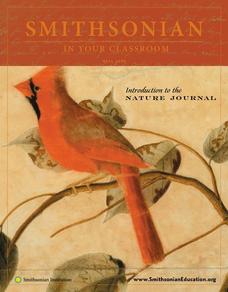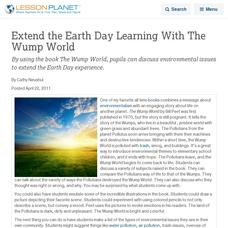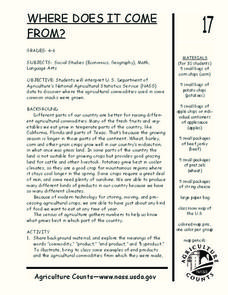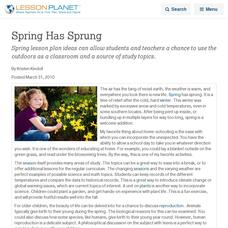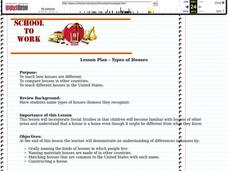Curated OER
Introduction to the Nature Journal
Students create nature journals. In this introduction to the nature journal instructional activity, students discover the uses of nature journals and begin their own. Students are challenged to use vivid, concise terms in their...
Curated OER
Extend the Earth Day Learning With "The Wump World"
By using the book "The Wump World," students can discuss environmental issues and extend the Earth Day experience.
Curated OER
Pika Chew
Students work in collaborative teams with specific roles, use the Internet to research the behavior and ecology of pikas, make predictions about survival rates of pikas in different habitats and organize their data in graphs.
Curated OER
African Power Figure Sculptures
Young scholars develop character, write short narrative about how it got its powers, and create a clay figure using modeling and assembling techniques to explore the concepts relating their figure to the African power figures.
Curated OER
Soil Recipe
Students examine the components of soil. They work together to use different materials to create their own soil. They make their own dirt cake as well.
Curated OER
The Buffalo War: A Clash of Cultures
Students view a documentary on the different values and meaning placed on the buffalo. Examining various cultures, they link the attitudes to the treatment of the animal in the wild. They develop solutions to the conflict raised by the...
Curated OER
SCRUMPTIOUS SOIL
Young scholars engage in investigations that lead to the discovery that earth materials consist of rocks, soils, water, and air. They build models of soil profiles, using breakfast cereal and other edible materials. They observe how...
Curated OER
Test Your Vocabulary Skills: More Common Idioms 2
In this language arts learning exercise, students discover that idioms are spoken or written sentences where the meaning is not obvious from the individual words used. Students read 10 idioms and match them to their meanings.
Curated OER
4-H Goat Activity Page
In this 4-H animal science worksheet, students will work with their parents and leaders to create goat project plan of what they want to learn in the year. Students will keep track of their goat related activities and complete a word...
Curated OER
What Makes Up Your Profile?
Second graders understand what a profile is and relate to the profile of soil. In this soil profile activity students use cereal to simulate soil profile. Students draw and label their profiles using accurate soil vocabulary.
Curated OER
Where Does It Come from?
Students read articles about various agricultural products and create a map using the statistics in the article. In this agricultural statistics lesson plan, students look at the geography of the country and which products come...
Curated OER
Adapt a Poem to a Wetland Habitat
In this adapt a poem to a wetland habitat worksheet, students read the poem "Over in the Meadow", then write 5 new stanzas using that format about a wetland or a swamp and its animals. This page has several links to helpful websites.
Curated OER
Seasons--Spring
Learning about the seasons, and the vocabulary associated with it, are important for both elementary and ESL students. Using an attractive and varied format, this 20 question activity has students identify words related to spring, and...
Curated OER
Blending Butterflies
Learners create camouflage butterflies. In this camouflage lesson plan, students read about the different types of camouflage. Each student in the class chooses a spot in the classroom and creates a camouflaged butterfly. They hang up...
Curated OER
Spring Has Sprung
Spring lesson plan ideas can allow students and teachers a chance to use the outdoors as a classroom and a source of study topics.
Curated OER
Types of Houses
Students orally name the kinds of houses in which people live. They name materials used in building houses in other countries. They construct a house.
Curated OER
Commas and Semicolons: Compound Sentences
For this comma and semicolon worksheet, students are given sentences that they must correctly punctuate using either a comma or a semicolon.
Curated OER
Do You Know Bamboo?
Students understand the properties of Bamboo and what it can be used for. For this bamboo lesson, students with bamboo and compare and contrast to wood. Students share their findings.
Curated OER
Terrariums: A Look at the Living and Nonliving World
Third graders examine life in a terrarium and relate it to life in a larger environment. In this terrarium instructional activity, 3rd graders examine how living and non-living things work together by examining the changes in a...
Curated OER
Long Rope Jumping
Students participate in long rope jumping. In this physical education lesson, students use four cones and a long rope to complete several activities. One students has the role of a "turner" and their partner is the "jumper." Each...
Curated OER
Animals Finding Rice Paddies
Fourth graders examine the animals who live in rice paddies and create a chart. For this rice lesson, 4th graders link the types of animals living in each ecosystem with a bar graph. Students use colored bars to show...
Curated OER
On, in, Under
In this sentence completion worksheet, students look at the pictures and complete the sentences using on, in, under, below, or above, and complete a crossword. Students complete 4 activities total.
Curated OER
Adaptations to Environments with Mammals
Fifth graders, after viewing a PowerPoint on different mammals, analyze what a biome is. Then they choose a mammal to research and go outside to feel the grass and leaves and hypothesize about which biome they live in as well as its...
Curated OER
Making Healthy Eating Choices for You and Others
Students use the USDA food guide pyramid to choose items for a balanced diet. In this food pyramid activity, students play a game naming the items and their foo groups. Students participate in cross curricular activities...
